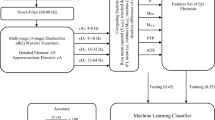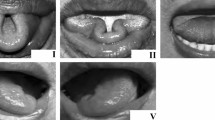Abstract
It has been shown that swallowing involves certain attentional and cognitive resources which, when disrupted can influence swallowing function with in dysphagic patient. However, there are still open questions regarding the influence of attention and cognitive demands on brain activity during swallowing. In order to understand how brain regions responsible for attention influence brain activity during swallowing, we compared brain organization during no-distraction swallowing and swallowing with distraction. Fifteen healthy male adults participated in the data collection process. Participants performed ten 1 ml, ten 5 ml, and ten 10 ml water swallows under both no-distraction conditions and during distraction while EEG signals were recorded. After standard pre-processing of the EEG signals, brain networks were formed using the time–frequency based synchrony measure. The brain networks formed were then compared between the two sets of conditions. Results showed that there are differences in the Delta, Theta, Alpha, Beta, and Gamma frequency bands between no-distraction swallowing and swallowing with distraction. Differences in the Delta and Theta frequency bands can be attributed to changes in subliminal processes, while changes in the Alpha and Beta frequency bands are directly associated with the various levels of attention and cognitive demands during swallowing process, and changes in the Gamma frequency band are due to changes in motor activity. Furthermore, we showed that variations in bolus volume influenced the swallowing brain networks in the Delta, Theta, Alpha, Beta, and Gamma frequency bands. Changes in the Delta, Theta, and Alpha frequency bands are due to sensory perturbations evoked by the various bolus volumes. Changes in the Beta frequency band are due to reallocation of cognitive demands, while changes in the Gamma frequency band are due to changes in motor activity produced by variations in bolus volume. These findings could potentially lead to the development of better understanding of the nature of dysphagia and various rehabilitation strategies for patients with neurogenic dysphagia who have altered attention or impaired cognitive functions.




Similar content being viewed by others
References
Achard S, Bullmore E (2007) Efficiency and cost of economical brain functional networks. PLoS Comput Biol 3(2):174–183
Aviyente S, Bernat EM, Evans WS, Sponheim SR (2011) A phase synchrony measure for quantifying dynamic functional integration in the brain. Hum Brain Mapp 32(1):80–93
Barrett AM, Burkholder S (2006) Monocular patching in subjects with right-hemisphere stroke affects perceptual-attentional bias. J Rehabil Res Dev 43(3):337–346
Bassett DS, Bullmore E (2006) Small-world brain networks. Neuroscientist 12(6):512–523
Bastian RW, Riggs LC (1999) Role of sensation in swallowing function. Laryngoscope 109(12):1974–1977
Brodsky MB, Abbott KV, McNeil MR, Palmer CV, Grayhack JP, Martin-Harris B (2012a) Effects of divided attention on swallowing in persons with idiopathic parkinsons disease. Dysphagia 27(3):390–400
Brodsky MB, McNeil MR, Martin-Harris B, Palmer CV, Grayhack JP, Abbott KV (2012b) Effects of divided attention on swallowing in healthy participants. Dysphagia 27(3):307–317
Cichero J, Murdoch BE (2006) Dysphagia: foundation, theory and practice. Wiley, New York
Corbetta M, Shulman GL (2002) Control of goal-directed and stimulus-driven attention in the brain. Nat Rev Neurosci 3:201–215
Curran J, Groher ME (1990) Development and dissemination of an aspiration risk reduction diet. Dysphagia 5(1):6–12
Daniels SK, Schroeder MF, DeGeorge PC, Corey DM, Rosenbek JC (2007) Effects of verbal cue on bolus flow during swallowing. Am J Speech Lang Pathol 16:140–147
Delorme A, Makeig S (2004) EEGLAB: an open source toolbox for analysis of single-trial EEG dynamics including independent component analysis. J Neurosci Methods 134(1):9–21
Dodds WJ (1989) The physiology of swallowing. Dysphagia 3(4):171–178
Doeltgen SH, Huckabee M-L (2012) Swallowing neurorehabilitation: from the research laboratory to routine clinical application. Arch Phys Med Rehabil 93(2):207–213
Ertekin C, Aydogdu I et al (2003) Neurophysiology of swallowing. Clin Neurophysiol 114(12):2226–2244
Feige B, Aertsen A, Kristeva-Feige R (2000) Dynamic synchronization between multiple cortical motor areas and muscle activity in phasic voluntary movements. J Neurophysiol 84(5):2622–2629
Foley NC, Martin RE, Salter KL, Teasell RW (2009) A review of the relationship between dysphagia and malnutrition following stroke. J Rehabil Med 41(9):707–713
Gottlieb D, Kipnis M, Sister E, Vardi Y, Brill S (1996) Validation of the 50 ml3 drinking test for evaluation of post-stroke dysphagia. Disabil Rehabil 18(10):529–532
Hamdy S, Aziz Q, Rothwell JC, Hobson A, Barlow J, Thompson DG (1997) Cranial nerve modulation of human cortical swallowing motor pathways. Am J Physiol Gastrointest Liver Physiol 272(4):G802–G808
Hamdy S, Mikulis DJ, Crawley A, Xue S, Lau H, Henry S, Diamant NE (1999) Cortical activation during human volitional swallowing: an event-related fmri study. Am J Physiol Gastrointest Liver Physiol 277(1):G219–G225
Hamdy S, Rothwell JC, Aziz Q, Thompson DG et al (2000) Organization and reorganization of human swallowing motor cortex: implications for recovery after stroke. Clin Sci 99(2):151–157
Herrmann CS, Mecklinger A (2001) Gamma activity in human EEG is related to highspeed memory comparisons during object selective attention. Vis Cogn 8(3–5):593–608
Hyvärinen A, Oja E (2000) Independent component analysis: algorithms and applications. Neural Netw 13(4):411–430
Jann K, Kottlow M, Dierks T, Boesch C, Koenig T (2010) Topographic electrophysiological signatures of fmri resting state networks. PLoS One 5(9):e12945
Jasper HH (1958) The ten twenty electrode system of the international federation. Electroencephalogr Clin Neurophysiol 10(1):371–375
Jestrović I, Coyle J, Sejdić E (2014) The effects of increased fluid viscosity on stationary characteristics of EEG signal in healthy adults. Brain Res 1589:45–53
Jestrović I, Coyle J, Sejdić E (2015a) Decoding human swallowing viaelectroencephalography: a state-of-the-artreview. J Neural Eng 12(5):1–15
Jestrović I, Coyle JL, Sejdić E (2015b) Characterizing functional connectivity patterns during saliva swallows in different head positions. J Neuroeng Rehabil 12(1):12–61
Jestrović I, Dudik JM, Luan B, Coyle JL, Sejdić E (2013) The effects of increased fluid viscosity on swallowing sounds in healthy adults. Biomed Eng Online 12(1):90–107
Klemm W, Lutes S, Hendrix D, Warrenburg S (1992) Topographical EEG maps of human responses to odors. Chem Senses 17(3):347–361
Klimesch W (1999) EEG alpha and theta oscillations reflect cognitive and memory performance: a review and analysis. Brain Res Rev 29(2):169–195
Kristeva-Feige R, Feige B, Makeig S, Ross B, Elbert T (1993) Oscillatory brain activity during a motor task. Neuroreport 4(12):1291–1294
Kristeva-Feige R, Fritsch C, Timmer J, Lücking C-H (2002) Effects of attention and precision of exerted force on beta range EEG-EMG synchronization during a maintained motor contraction task. Clin Neurophysiol 113(1):124–131
Lakatos P, Karmos G, Mehta AD, Ulbert I, Schroeder CE (2008) Entrainment of neuronal oscillations as a mechanism of attentional selection. Science 320(5872):110–113
Lazarus C, Logemann J (1987) Swallowing disorders in closed head trauma patients. Arch Phys Med Rehabil 68(2):79–84
Logemann JA (2006) Medical and rehabilitative therapy of oral, pharyngeal motor disorders. GI Motil Online. doi:10.1038/gimo50
Lorig TS, Huffman E, DeMartino A, DeMarco J (1991) The effects of low concentration odors on EEG activity and behavior. J Psychophysiol 5(1):69–77
Marik PE, Kaplan D (2003) Aspiration pneumonia and dysphagia in the elderly. CHEST J 124(1):328–336
Marrufo MV, Vaquero E, Cardoso MJ, Gómez CM (2001) Temporal evolution of alpha and beta bands during visual spatial attention. Cogn Brain Res 12(2):315–320
Maslov S, Sneppen K (2002) Specificity and stability in topology of protein networks. Science 296(5569):910–913
Massey BT (2006) Physiology of oral cavity, pharynx and upper esophageal sphincter. GI Motil Online
Matsuo K, Palmer JB (2008) Anatomy and physiology of feeding and swallowing: normal and abnormal. Phys Med Rehabil Clin N Am 19(4):691–707
Mattingley JB, Bradshaw JL, Bradshaw JA, Nettleton NC (1994) Residual rightward attentional bias after apparent recovery from right hemisphere damage: implications for a multicomponent model of neglect. J Neurol Neurosurg Psychiatry 57(5):597–604
McHorney CA, Bricker DE, Robbins J, Kramer AE, Rosenbek JC, Chignell KA (2000) The SWAL-QOL outcomes tool for oropharyngeal dysphagiain adults: II. Item reduction and preliminary scaling. Dysphagia 15(3):122–133
Michou E, Hamdy S (2009) Cortical input in control of swallowing. Curr Opin Otolaryngol Head Neck Surg 17(3):166–171
Milnik A, Nowak I, Müller NG (2013) Attention-dependent modulation of neural activity in primary sensorimotor cortex. Brain Behav 3(2):54–66
Mosier KM, Liu W-C, Maldjian JA, Shah R, Modi B (1999) Lateralization of cortical function in swallowing: a functional mr imaging study. Am J Neuroradiol 20(8):1520–1526
Murray J (1999) Manual of dysphagia assessment in adults. Singular, San Diego
Murthy VN, Fetz EE (1992) Coherent 25-to 35-hz oscillations in the sensorimotor cortex of awake behaving monkeys. Proc Natl Acad Sci 89(12):5670–5674
Murthy VN, Fetz EE (1996) Oscillatory activity in sensorimotor cortex of awake monkeys: synchronization of local field potentials and relation to behavior. J Neurophysiol 76(6):3949–3967
Nagy A, Leigh C, Hori SF, Molfenter SM, Shariff T, Steele CM (2013) Timing differences between cued and noncued swallows in healthy young adults. Dysphagia 28(3):428–434
Niedermeyer E, da Silva FL (2005) Electroencephalography: basic principles, clinical applications, and related fields. Lippincott Williams & Wilkins, Philadelphia
Nonaka T, Yoshida M, Yamaguchi T, Uchida A, Ohba H, Oka S, Nakajima I (2009) Contingent negative variations associated with command swallowing in humans. Clin Neurophysiol 120(10):1845–1851
Perlman AL, Schultz JG, VanDaele DJ (1993) Effects of age, gender, bolus volume, and bolus viscosity on oropharyngeal pressure during swallowing. J Appl Physiol 75(1):33–37
Robbins J (2011) Upper aerodigestive tract neurofunctional mechanisms: lifelong evolution and exercise. Head Neck 33(S1):S30–S36
Rogers B, Arvedson J, Buck G, Smart P, Msall M (1994) Characteristics of dysphagia in children with cerebral palsy. Dysphagia 9(1):69–73
Rubinov M, Sporns O (2010) Complex network measures of brain connectivity: uses and interpretations. Neuroimage 52(3):1059–1069
Sanes JN, Donoghue JP (1993) Oscillations in local field potentials of the primate motor cortex during voluntary movement. Proc Natl Acad Sci 90(10):4470–4474
Smithard D, O’neill P, Park C, Morris J, Wyatt R, England R, Martin D (1996) Complications and outcome after acute stroke does dysphagia matter? Stroke 27(7):1200–1204
Sporns O, Zwi JD (2004) The small world of the cerebral cortex. Neuroinformatics 2(2):145–162
Stam CJ, Reijneveld JC (2007) Graph theoretical analysis of complex networks in the brain. Nonlinear Biomed Phys 1(1):1–19
Stevenson RD, Allaire JH (1991) The development of normal feeding and swallowing. Pediatr Clin N Am 38(6):1439–1453
Strogatz SH (2001) Exploring complex networks. Nature 410(6825):268–276
Yagyu T, Kondakor I, Kochi K, Koenig T, Lehmann D, Kinoshita T, Hirota T, Yagyu T (1998) Smell and taste of chewing gum affect frequency domain EEG source localizations. Int J Neurosci 93(3–4):205–216
Yamagishi N, Callan DE, Goda N, Anderson SJ, Yoshida Y, Kawato M (2003) Attentional modulation of oscillatory activity in human visual cortex. Neuroimage 20(1):98–113
Acknowledgements
Research reported in this publication was supported by the Eunice Kennedy Shriver National Institute of Child Health & Human Development of the National Institutes of Health under Award number R01HD074819. The content is solely the responsibility of the authors and does not necessarily represent the official views of the National Institutes of Health.
Author information
Authors and Affiliations
Corresponding author
Rights and permissions
About this article
Cite this article
Jestrović, I., Coyle, J.L., Perera, S. et al. Influence of attention and bolus volume on brain organization during swallowing . Brain Struct Funct 223, 955–964 (2018). https://doi.org/10.1007/s00429-017-1535-7
Received:
Accepted:
Published:
Issue Date:
DOI: https://doi.org/10.1007/s00429-017-1535-7




